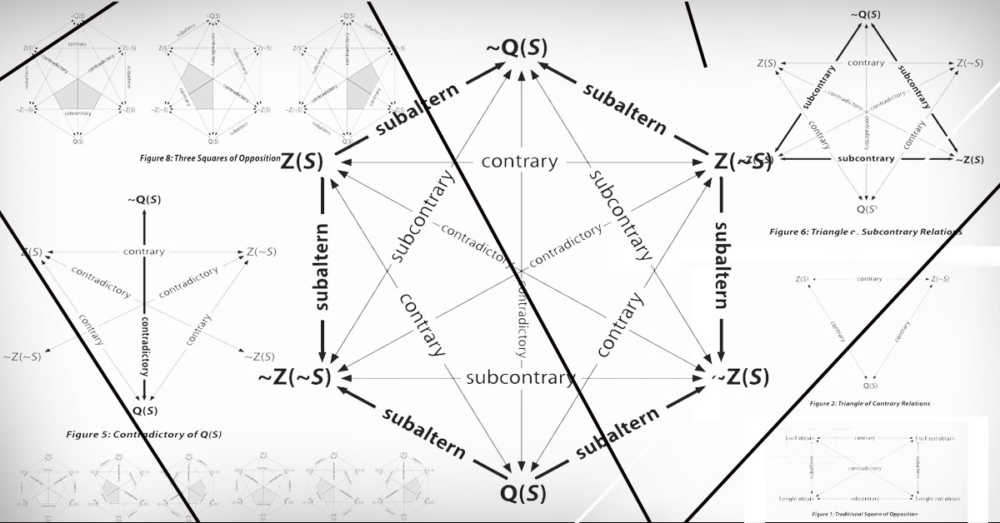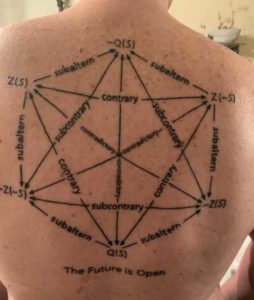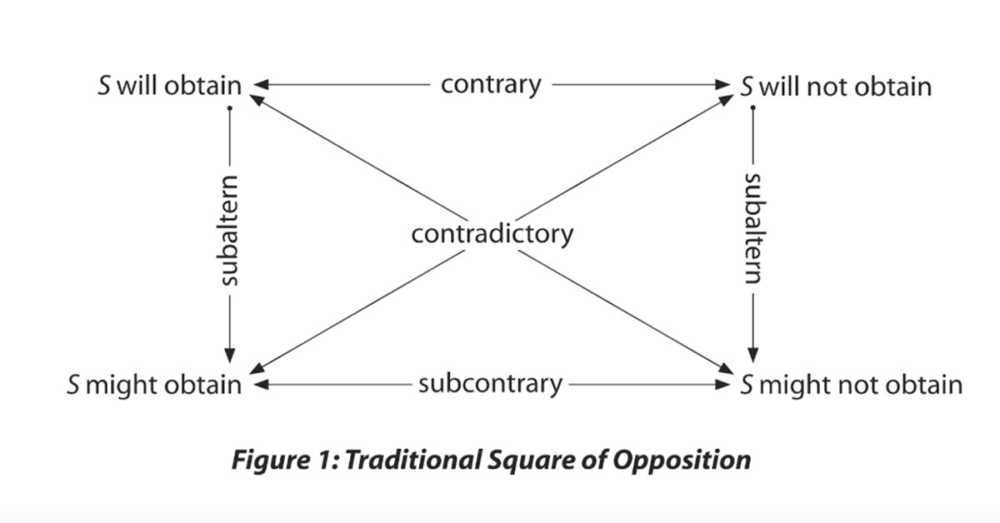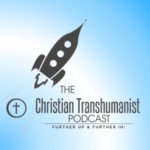We run our website the way we wished the whole internet worked: we provide high quality original content with no ads. We are funded solely by your direct support. Please consider supporting this project.

The Logical Hexagon Made Simple
by: Greg Boyd
The Hexagaon in a Nutshell
For those of you who don’t have the twenty to thirty minutes it will probably take to read this essay but who nevertheless would like to have some idea of what the Logical Hexagon is all about, here is my two sentence elevator speech:
The Logical Hexagon demonstrates that, on the assumption that people possess free will, then the future must be described not only in terms of what WILL and WILL NOT come to pass, but also in terms of what MIGHT and MIGHT NOT come to pass. And precisely because an omniscient God must know the whole of reality exactly as it is, God must know the future partly in terms of what MIGHT and MIGHT NOT come to pass.
A Slighter Longer Explanation
And now, for those who have the time, here is a fuller explanation.[1]
 That tattoo on my back is formally called the “Hexagon of Opposition” because it claims to correct and improve upon Aristotle’s famous “Square of Opposition.” But “opposition” sounds rather combative to non-logicians, so I prefer to refer to this diagram simply as “the Logical Hexagon,” or simply as “the Hexagon.” This Hexagon was created by Alan Rhoda, Tom Belt and myself in 2005 in response to a defect we discerned in Aristotle’s Square that prejudiced western logic in a deterministic direction. In the process, we discovered that the Logical Hexagon also makes clear why acknowledging that God doesn’t know what a future free agent will choose to do does not in any way qualify God’s omniscience. And the Hexagon has a number of other potential philosophical and/or theological implications as well, as I’ve argued in several articles.[2]
That tattoo on my back is formally called the “Hexagon of Opposition” because it claims to correct and improve upon Aristotle’s famous “Square of Opposition.” But “opposition” sounds rather combative to non-logicians, so I prefer to refer to this diagram simply as “the Logical Hexagon,” or simply as “the Hexagon.” This Hexagon was created by Alan Rhoda, Tom Belt and myself in 2005 in response to a defect we discerned in Aristotle’s Square that prejudiced western logic in a deterministic direction. In the process, we discovered that the Logical Hexagon also makes clear why acknowledging that God doesn’t know what a future free agent will choose to do does not in any way qualify God’s omniscience. And the Hexagon has a number of other potential philosophical and/or theological implications as well, as I’ve argued in several articles.[2]
Almost from the start I felt that the Hexagon was simply too elegant not to be true, so much so that I promised myself that I would have it tattooed on my back if I ever became sufficiently convinced it was valid. Well, thanks to the brilliant defense of the Hexagon by Elijah Hess against the critiques of William Lane Craig and others, I’ve decided I’m probably as convinced as I’m ever going to be.[3] So, on Tuesday, January 7th, 2020, my friend and Tattoo-artist extraordinaire, Cliff Clayton, graciously volunteered to tattoo the Hexagon on my back in exchange for nothing more than some one-on-one theology talk time. It obviously was a very gracious offer on Cliff’s part![4]
In a previous post I talked about the (shockingly unpleasant!) experience of getting this tattoo (link). Today I’d like to explain the Hexagon itself in as short and simple terms as possible.
I’ll admit up front that communicating the Hexagon simply isn’t easy, for the Hexagon employs philosophical terms, symbols, and formulae that most people are unfamiliar with. I did my best, but be forewarned: you may come upon sections in this essay that strike you as rather dense. I encourage you to plough through them. I think you’ll find that, more often than not, the challenging material is explained by subsequent easier material.
The payoff for your effort is not simply that you’ll understand an awesome looking logical diagram. If you press through this, you may just find yourself beginning to think about God, the future, free will, and providence in a more beautiful and a more helpful way.
I’ll start by introducing the several key logical terms as well as the three symbols (called “logical operators”) found on the Hexagon. I put this material upfront as a sort of prelude since I suspect some readers may find it helpful to come back to this section to refresh their memory as they read this essay. Following this, I will provide a brief explanation and critique of Aristotle’s Square of Opposition, arguing that it is prejudiced toward determinism. And I will then lead readers through the three steps that transform Aristotle’s Square into the Logical Hexagon.
———-
Key Terms
Contradictory: A proposition holds a contradictory relationship with another proposition if and only if one of the two propositions must be true and the other false.
Contrary: A proposition holds a contrary relationship with another proposition if and only if they cannot be conjointly true but may be conjointly false.
Subcontrary: A propositions holds a subcontrary relationship with another proposition if and only if the propositions cannot be conjointly false but may be conjointly true. Subaltern: A proposition holds a subaltern relationship with another proposition if and only if the truth of one proposition entails the truth of another, while the converse is not true.
Logical Operators
Z = “settled”; “will definitely happen,” “definite fact”
Q = ““unsettled”, “might and might not happen,” :indefinite possibilities”
S = “future state of affairs”
~ = not
Hence,
Z(S) = S will come to pass
Z(~S) = S will not come to pass
Q(S) = S might and might not come to pass
Aristotle’s Square of Opposition
There are three distinct ways that we may speak about future events . We may say that a particular future event (S) “will obtain” (=”come to pass”). We may say that this event (S) “will not obtain.” Or we can say that this event (S) “might or might not obtain.” To illustrate, it may be true that Sam will buy a blue Toyota at 3:10PM on June 12th, 2025 (henceforth BT25). Conversely, it may be true that Sam will not buy a BT25. Or, it may be true that Sam might and might not buy a BT25.
On Aristotle’s traditional Square of Opposition, the logical relationships between these three ways of describing the future are as follows.

Rhoda, Belt and I noticed a curious defect in Aristotle’s Square. It is prejudiced toward determinism in as much as it has a distinct logical operator to assert “S will obtain” [Z(S)] and to assert “S will not obtain” [Z(~S)], but to affirm “S may or may not obtain,” one must affirm the conjoint truth of the two subcontrary relations (“S might” and “S might not” obtain). The Logical Hexagon began with the realization that a comprehensive logical map of the logical relationships that pertain between propositions asserting one of the three logically possible future state of affairs ought to express the open dimension of the future (“might and might not’) as fundamentally as it expresses the settled dimension of the future (“will” and “will not”). The open dimension thus ought to be represented by its own logical operator (Q).
I will now review the three steps that were taken to transform Aristotle’s Square into the Logical Hexagon.
1. The Triangle of Contrary Relations
To begin, lets inquire into the logical relationship that exists between propositions asserting these three possible future state of affairs, Z(S), Z (~S)), Q(S). When any one of these three obtains, the other two cannot. Since no two of these three possible future states can be conjointly true, while two of the three must be conjointly false, propositions asserting these three possible future states of affairs are related to each other as contraries, which can be illustrated as follows:

Notice that, if it is true that the future is as yet unsettled as to whether or not Sam will buy a BT25 [Q(S)] , then it is false both that Sam will buy a BT25 [Z(S)]] and false that Sam will not buy BT25 [Z(~S)]. I grant that sounds counterintuitive, since Sam obviously either will or will not end up buying a BT25. However, while it’s true that Sam will eventually choose to buy a BT25 or not, this doesn’t mean that the truth of what he will end up choosing predated his choosing it.
Philosophers frequently note that common language is designed for common use, which is why it is often inadequate at capturing philosophical nuances. This is certainly the case when it comes to talking about the three possible future states of affairs. To clarify how Z(S) (“will”) and Z(~S) (“will not”) can be conjointly false, we simply need to note that Z(S )and Z(~S) assert a definiteness over the future that Q(S) denies. . To assert that “Sam will or will not buy a BT25” is to assert that “Sam will definitely,” or “Sam will definitely not buy a BT25.” In other words, to say “will” or “will not” is to assert a settled fact about the future that negates the possibility that things might turn out otherwise.
By contrast, to assert that “Sam might and might buy a BT25” is to deny that there is any definite fact of the matter about whether Sam will or will not purchase a BT25. Hence, if it is true that Sam might and might not buy this car on this date, then it is false both that Sam definitely will buy this car on this date — because he might not — and false that Sam definitely will not buy this car on this date — because he might. Hence, if Q(S) is true, the contrary relationships Z(S) and Z(-S) must both be false.
There are three significant implications that follow from this Triangle of Contrary Relations. First, it demonstrates that it is logically possible for the future to be genuinely open, to one degree or another. And, while I can’t make the case now, I would argue that this logical possibility must be accepted as a description of the actual future if you accept, , as I do, that the Creator has endowed humans (and possibly other agents) with morally responsible free will. This will empower us to resolve a multitude of possible courses of action into one actual course of action.
Hence, prior to my resolving a number of possible decisions into one actual decision, the only fact-of-the matter pertaining to my future decision is that I might choose X or that I might choose Y. Hence, prior to my decision, it is false both that I will (definitely) chose X and false that I will (definitely) not chose Y. Moreover, since an omniscient God must know reality exactly as it is, God would not know what I will (definitely) or will (definitely) not do, precisely because God perfectly knows what I might and might not do.[5] As the Bible itself indicates, this entails that, insofar as people possess free will, God must think about the future in terms of what might or might not happen rather than exclusively in terms of what will and will not happen.[6]
Second, against the dominant strand of the western philosophical tradition, this Triangle of Contrary Relations makes it clear that the truth value of propositions asserting future states of affairs that might or might not come to pass (Q) are not timeless. While it may be true prior to 2025 that “Sam might or might not buy a BT25,” as the date of this possible purchase approaches, it will inevitably become true either that ‘Sam will [definitely] buy a BT25,” or that “Sam will [definitely] not buy a BT25.” When this happens, it will of course become false that “Sam may or may not buy a BT25.” Once a possibility becomes a settled fact, there are no “maybes” about it.
In other words, the Logical Hexagon makes it clear that the truth value of propositions asserting future states of affairs must always be indexed to particular points in time. Whether it is true that Sam will (definitely) or will (definitely) not buy a BT25, or whether it is true that Sam might or might not buy a BT25, depends entirely on when the statement is made.
And third, in contrast to Aristotle’s Square, the Logical Hexagon makes clear a distinction between “might” when it is functioning as the subaltern of “will,” on the one hand, and “might” when it is functioning as the contradictory of “will” and “will not” and when conjointly true with “might not.” When “might” functions as the subaltern of “will,” it only expresses an epistemic limitation. If it is true that “Sam will purchase a BT25,” then we would only say “Sam might purchase a BT25” if we were ignorant of that truth. By contrast, when “might” and “might not” are conjointly true and “will” and “will not” are conjointly false, “might” is no longer merely expressing epistemic ignorance: it is expressing an ontological state of affairs on a par with “will” and “will not” propositions, which is precisely why it warrants its own logical operator (Q).
2. The Triangle of Subcontrary Relations
Bivalence is a rule of logic that asserts that every meaningful proposition is either true or false, which is to say, either this proposition or its contradictory must be true. To further flesh out the logical relations that pertain between the three possible future states of affairs, I’d like to apply the law of bivalence to the three foundational poles that comprise the Triangle of Contrary Relations. When we do this, we will find that it generates a further Triangle of Subcontrary Relations.
Consider Z(S). As we saw above, common parlance sometimes leads people to mistakenly assume that the contradictory of “Sam will buy a BT25,” is “Sam will not buy a BT25.” Yet, as I demonstrated above, these cannot be contradictory since they can be conjointly false, as is the case when “Sam might and might not buy a BT25.” The contradictory of “Sam will (definitely) buy a BT25” [Z(S)] is not “Sam will (definitely) not by a BT25,” [Z(~S)] but rather, “It is not the case that Sam will (definitely) buy a BT25 [~ Z(S)], which is equivalent to “Sam might not buy a BT25,”
Similarly, the contradictory of “Sam will not buy a BT25” [Z(~S)] is not, “Sam will buy a BT25” [Z(S)], but rather, “It is not the case that Sam will (definitely) not buy a BT25” [~Z(~S)], which is equivalent to “Sam might buy a BT25.” We can illustrate this as follows:

Lastly, the contradictory of the third possible future state of affairs – what “might and might not” obtain [Q(S)}– is ~Q(S), which asserts, “It is not the case that future event (S) is unsettled, indeterminate, or open,” which is to say that it is the case that future event (S) is settled,” whether as “will” [Z(S)] or “will not”[ Z(~S)]. We can illustrate this as followers:

Let’s now inquire into the logical relationship between these three contradictories, ~Z(S), ~Z(~S) and ~Q(S). Fleshing out these relationships involves talking about the truth and falsehood of negations, which can get a little convoluted. Some readers might want to simply take my word for it and skip to the last sentence of the following paragraph.
To begin, we’ve seen that Q(S) entails both ~Z(S) and ~Z(~S). If at any given time it is true that Sam might and might not purchase a BT25, then it is false that Sam will (definitely) purchase a BT25 and false that Sam will (definitely) not purchase a BT25. But it is equally clear that ~Z(S) and ~Z(~S) cannot be conjointly false, for if ~Z(S) is false, then Z(S) is necessarily true, and if ~Z(~S) is false, then Z(~S) is necessarily true. But Z(S) and Z(~S) cannot be conjointly true, from which it follows that ~Z(S) and ~Z(~S) cannot be conjointly false. The same holds true for the other pairs, ~Z(S) and ~Q(S) as well as ~Z(~S) and ~Q(S)]. For each pair, it is logical possible for both to be true but not logically possible for both to be false, which means that they are related to each other as subcontraries. These can be illustrated as follows:

3. The Hexagon of Subaltern Relations
Having reviewed the contradictory, contrary, and subcontrary relations involved in the Hexagon, the final step is to explore the logical relationship that exists between the Triangle of Contrary Relations and the Triangle of Sub-Contrary Relations. This involves demonstrating the logical relations that exist between the six operators that comprise the parameter of the Hexagon.
Consider the relationship between Z(S) and ~Z(~S). If it is true that Sam will (definitely) purchase a BT25, then it must also be true that Sam might purchase a BT25. However, to say that Sam might purchase a BT25 does not entail that Sam will purchase a BT25, for as we’ve seen, might and might not may be conjointly true, in which case it is false both that Sam will (definitely) purchase a BT25 and false that Sam will (definitely) not purchase a BT25. Hence, while Z(S) impies ~Z(~S), the converse is not true, which means that ~Z(~S) is the subaltern of Z (S). This same relationship connects all the logical operators that comprise the parameter of the Hexagon. In the following illustration, which presents the Hexagon in its entirety, the one-sided arrows that form the Hexagon point toward the subaltern,
Voila!

One More Curious Thing
There is one final cool feature of the Hexagon that I would think a nerd like yourself would want to know about (if you’re still reading this, you’re a nerd!). A short while after the Hexagon was completed, Tom Belt noticed that the Hexagon contained three versions of Aristotle’s Square, each expressing the contradictory, contrary, and subaltern relationships that pertain to each of the three possible future states.

In my estimation, this triplication of Aristotle’s Square confirms that, to accurately and comprehensively map out the logical relationships that pertain to the three possible future states of affairs, we need to postulate three, not two, possible future states of being [Z(S), Z(~S), and Q(S], and the logic of Aristotle’s square needs to be worked out for each one.
Conclusion
Most people in western culture have assumed that God knows all that will come to pass because they assumed that the future can be exhaustively defined as the realm of what will and will not come to pass. And if this assumption is true, then denying God knows what will happen in the future is tantamount to denying omniscience. However, the Hexagon exposes the error of this assumption by making explicit something that could only be indirectly inferred from Aristotle’s Square: namely, that the future may also be comprised of what may or may not come to pass, and to this degree, an omniscient God must know the future as a domain of what may or may not come to pass.
In this light, I trust it’s clear why acknowledging that God doesn’t know what a future free agent will (definitely) choose does not imply any limitation on God’s omniscience.
Bless you,
as you move into a future
filled with possibilities!
Greg
___ ___ ___
1—This post is essentially a popularization of R. Rhoda, G. Boyd, T. Belt, “The Hexagon of Opposition” (unpublished manuscript).
2—G. Boyd, “Two Ancient (and Modern) Motivations For Ascribing Exhaustively Definite Foreknowledge to God: A Historic Overview and Critical Assessment,” Religious Studies, 46:1 (March, 2010), 41-59.; G. Boyd, “Neo-Molinism and the Infinite Intelligence of God.” Philosophi Christi, 5.1 (2003), 187-204.
3—See also E. Hess, “Arguing From Molinism to Neo-Molinism,” Philosophi Christi, 17, no..2 (2015), 331-351; Hess, “Has Molina Collapsed the Neo-Molinist Square? A Rejoinder to Kirk MacGregor,” Philosophia Christi (forthcoming).
4—In case you happen to be looking for a tattoo artists in the Twin Cities area, Clifton Carter works out of Leviticus (awesome shop, by the way) in Minneapolis, MN.
5—This point needs to be nuanced. Our choices become habits, and our habis, if we persist in them, form our character. To the degree that a person’s character is solidified, they cannot make choices that are inconsistent with this character. Hence, a person’s solidified character may render it certain at any given point in time that they will (definitely) choose X instead of Y. Yet, the choice of X may still be considered a free and morally responsible choice if this person could have chosen otherwise had they in the past freely chosen to form a different kind of character.
6—For example, in Exodus 13:17 we read: “When Pharaoh let the people go, God did not lead them by way of the land of the Philistines, although that was nearer; for God thought, “If the people face war, they may change their minds and return to Egypt” (emphasis added). For an overview of biblical passages suggesting an open future, see G. Boyd, The God of the Possible: A Biblical Introduction to the Open View of God (Grand Rapids, MI: Baker, 2001). We could almost sum up the significance of the Logical Hexagon simply by claiming that it explains how an omniscient God could think about the future in terms of “ifs” and “maybes.”
Category: Essays, General
Tags: Free Will, Open Future, Open Theism, Philosophy
Topics: Defending the Open View, Free Will and the Future, Providence, Predestination and Free Will
Related Reading

Paul Teaches Free Will, Not Determinism: Romans 9, Part 3
In this series of posts, I am challenging the deterministic reading of Romans 9, which interprets Paul’s teaching as saying that God chooses some to be saved and others to be damned. There are six arguments that I offer to challenge this popular view. Today, I will look at the fourth. Argument #4: Paul’s Summary and…

Greg’s Interview on The Christian Transhumanist Podcast
Here is an interview I did for The Christian Transhumanist Podcast that I wanted to share with all of you. Micah Redding and I discuss everything from Relativity Theory to Politics. I think you’ll find it interesting, but I want to offer a word of clarification before you listen. At one point in this interview…

Revelation 17:8 refers to people whose names haven’t been written in “the book of life from the creation of the world.” Doesn’t this conflict with open theism?
As in Revelation 13:8, the clause “from the foundation” (apo kataboleis) need not mean “from before the foundation” but simply “from the foundation” (= since the foundation). It’s not that names either were or were not written in the “book of life” before they were ever born. Rather, throughout history, in response to the choices…

Why Compatibilistic Freedom Does Not Make Sense
Compatibilism is the view that free will is compatible with determinism. In this view, freedom is defined as the ability to do what you want, though what you want is determined by factors outside of you. Theologians who espouse this perspective, hold that God ultimately determines what individuals want. This is in contrast to “self-determining…

Reflections on the Influence, and Damage, of Plato’s Timaeus 28a
The Timaeus is Plato’s account of the creation of the world. Ancient philosophers were divided as to whether Plato meant the work to be taken literally or mythically, as are modern scholars. The work was arguably the single most cited work by early church fathers. And the text I want to reflect on (28a) is…

How do you respond to Genesis 16:12?
The Lord describes Ishmael as “…a wild ass of a man, with his hand against everyone, and everyone’s hand against him.” According to most Old Testament scholars the Lord is describing Ishmael’s descendants as much as he is describing Ishmael himself. The Lord foresaw that the nation which would descend from Ishmael (cf. 21:18) would…
